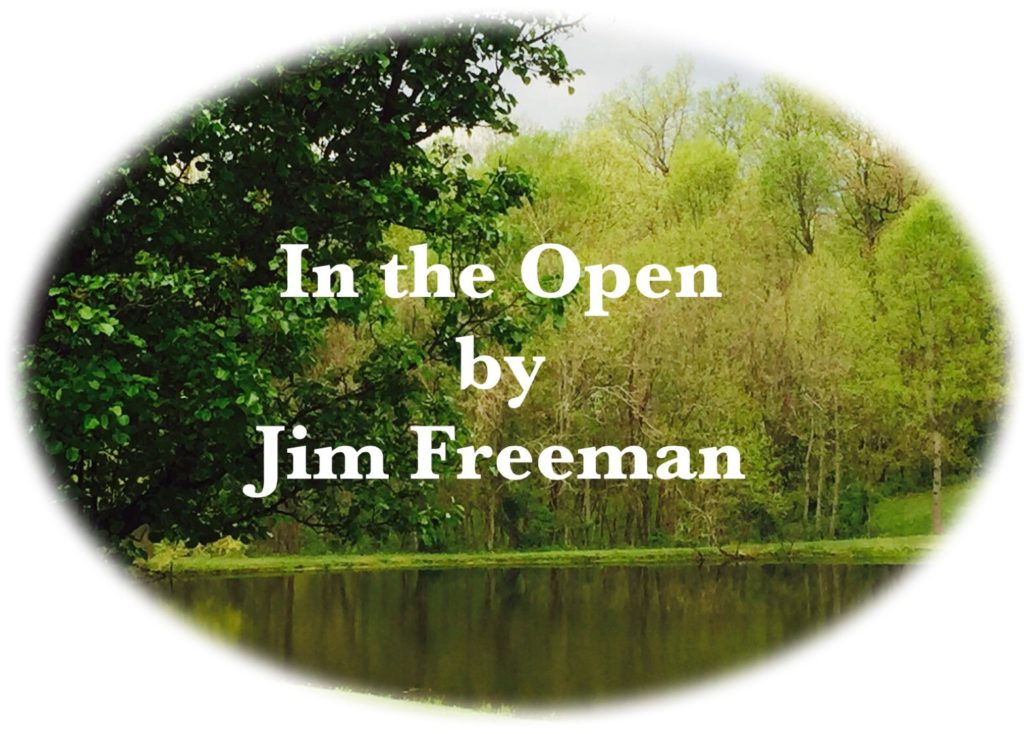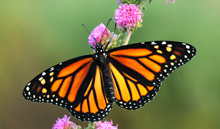Monarch – King of the Butterflies


Think of a butterfly.
If you did, chances are very good the image that popped into your mind was of the familiar orange and black, white-spotted Monarch butterfly. If so, there is a good reason for that – most of have seen the beautiful Monarch butterfly, the King of the Butterflies.
I’ve seen a lot of Monarchs this summer and am not sure if it is because I am paying more attention to them or if there are indeed more, but they seem to be plentiful this year, which is a great thing.
I don’t claim to be a very religious man, but if the Monarch’s complex metamorphosis from an egg to an adult butterfly, coupled with its annual, multi-generational migration don’t make you ponder the existence of a Supreme Being, nothing else will.
The Monarchs you are seeing now are three or four generations removed from the ones that left a forested mountainside in central Mexico earlier this year. The butterflies migrate north, lay eggs and die, and their offspring continue the journey. No one Monarch sees the entire journey.
Furthermore, each of the four generations goes through four stages (egg, caterpillar, chrysalis, adult) just to be able to make the trip.

The fourth generation of Monarchs, born in September and October, is special – they go through the same growth stages of the first three generations, but these butterflies don’t die after a few short weeks. The fourth generation lives for six to eight months, long enough to complete the migration to Mexico and then start the whole process over again.
The Monarchs use the same tree from year-to-year, which is especially strange because these aren’t the same butterflies that left earlier this year – they are essentially the great-grandchildren of the ones that left Mexico this spring. A Monarch butterfly never sees its parents, there is no knowledge shared from one generation to the next, no directions or maps are passed down, yet the Monarch butterflies continue their journey.
Jenny Ridenour, the Meigs Soil and Water Conservation District education coordinator, had an idea to feature a butterfly enclosure with Monarchs at this year’s Conservation Corner, an exhibit at the Meigs County Fair which we share with the Ohio Department of Natural Resources-Division of Wildlife, the Natural Resources Conservation Service, and the Ohio Farm Bureau. Every day the people stopped by to see what had changed overnight, and after the fair we wound up with the caterpillars in our office, so we got to see the incredible transformation played out numerous times. In addition, several classrooms at Southern and Meigs elementary schools, and Tuppers Plains Pre-school adopted some of the caterpillars are raising them.
Sadly, the Monarch population is not doing well; it is threatened by illegal logging in the over-wintering sites of Mexico, and in the U.S. and Canada by the eradication of habitat and the milkweed plants that it needs to carry on its life-cycle and migration. Even though they appear abundant, their population has greatly decreased to the point researches fear it may reach a tipping point resulting in a collapse of the migration or even the extinction of the species.
If you live in the country, one way you can help the Monarchs is by literally doing nothing – nothing as in not cutting or mowing the milkweed plants they need to complete their live cycle. That is because Monarch butterflies will only lay eggs on milkweed plants, and their caterpillars can eat nothing but milkweed leaves. No milkweed, no Monarchs.
I understand that many in the agricultural community don’t like milkweed. Part of the problem is that Common Milkweed closely resembles another plant, the aggressive Hemp Dogbane; they look alike, especially when young, and both make milky sap.
I did my part to help the Monarchs by not mowing a couple of places on the farm where milkweed plants grow – odds and ends, places that don’t need mowing right now anyhow – then the butterflies took care of the rest. A few days ago, I stopped and examined the plants, many of them were eaten by caterpillars or still had caterpillars on them.
It not all about the butterflies. It’s also about the birds and bees, setting aside those little patches of habitat helps other wildlife species and pollinators including bees and hummingbirds, which we depend on to pollinate many of our food crops.
I’ve also created a little milkweed garden by the house which attracts many different types of pollinating insects and butterflies. The garden consists of Poke Milkweed (not to be confused with regular Poke), Common Milkweed, Swamp Milkweed, Tall Green Milkweed (not a very imaginative name), and Butterfly Weed (which is related to milkweeds). The plants are colorful when flowering and mostly maintenance free – not to mention it is cool to see Monarch caterpillars using them.
It is still not too late to help the Monarchs. The Meigs SWCD is collecting milkweed seed pods from now until the beginning of October. The seed will be processed and redistributed this upcoming spring for planting. Where there is milkweed, there are Monarchs! For more information about helping Monarch butterflies or the seed pod collection, contact the Meigs Soil and Water Conservation District weekdays at 740-992-4282.
Jim Freeman is the Meigs SWCD wildlife specialist. He can be contacted weekdays at 740-992-4282 or at [email protected]






